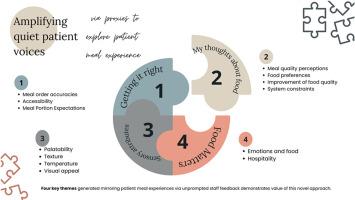放大安静的病人的声音:通过代理反馈捕捉病人的用餐体验
IF 7.4
2区 医学
Q1 NUTRITION & DIETETICS
引用次数: 0
摘要
背景和目的目前用于评估医院患者用餐体验的工具通常强调感官质量、用餐环境和营养摄入。然而,这些方法通常排除了由于虚弱、认知障碍或语言障碍限制数据代表性而在提供直接反馈方面面临挑战的患者。为了解决这一差距,本研究通过在日常实时互动中从医护人员收集的代理反馈来探索患者的用餐时间体验。此外,我们评估了这种新方法在捕捉“安静的病人”的观点方面的效用和有效性,否则他们可能会保持沉默。方法本探索性定性研究采用解释性描述方法收集和分析一家老年康复机构工作人员在四周时间内记录的代理反馈。由工作人员组成的焦点小组进一步评估了该方法的有效性。27名参与者对78篇日志进行了专题分析,确定了四个关键主题:做对了,我怎么办?,食物吸引力的感官动态,食物真的很重要。此外,关于该工具的实用性,焦点小组提出了两个主要主题:该方法的潜力和帮助患者发声。结论代理反馈方法有效地放大了安静患者的声音,是传统调查的补充。它的实时便利性和用户友好性为更包容和全面地了解患者用餐时间体验提供了有价值的辅助。本文章由计算机程序翻译,如有差异,请以英文原文为准。

Amplifying the quiet patient voices: Capturing patient meal experiences through proxy feedback
Background and aims
Current tools for evaluating patient meal experiences in hospitals often emphasise sensory qualities, dining environment, and nutritional intake. However, these approaches typically exclude patients who face challenges in providing direct feedback due to frailty, cognitive impairments, or language barriers limiting the representativeness of the data. To address this gap, this study explored patient mealtime experiences through proxy feedback collected from healthcare staff during routine real-time interactions. Furthermore, we evaluated the utility and effectiveness of this novel approach in capturing the perspectives of ‘quiet patients’, who might otherwise remain unheard.
Methods
This exploratory qualitative study employed interpretive description methodology to gather and analyse proxy feedback documented by staff over a four-week period in a geriatric and rehabilitation facility. A focus group with staff further assessed the methodology's effectiveness.
Results
Thematic analysis of 78 logs by 27 participants identified four key themes: Getting it right, What about me?, Sensory dynamics of meal appeal, and Food really matters. Additionally, two main themes emerged from the focus group regarding the tool's utility: The potential of this method and Helping give patients their voice.
Conclusions
The proxy feedback approach effectively amplified quiet patients’ voices, complementing traditional surveys. Its real-time convenience and user-friendliness offer a valuable adjunct for a more inclusive and comprehensive understanding of patient mealtime experiences.
求助全文
通过发布文献求助,成功后即可免费获取论文全文。
去求助
来源期刊

Clinical nutrition
医学-营养学
CiteScore
14.10
自引率
6.30%
发文量
356
审稿时长
28 days
期刊介绍:
Clinical Nutrition, the official journal of ESPEN, The European Society for Clinical Nutrition and Metabolism, is an international journal providing essential scientific information on nutritional and metabolic care and the relationship between nutrition and disease both in the setting of basic science and clinical practice. Published bi-monthly, each issue combines original articles and reviews providing an invaluable reference for any specialist concerned with these fields.
 求助内容:
求助内容: 应助结果提醒方式:
应助结果提醒方式:


